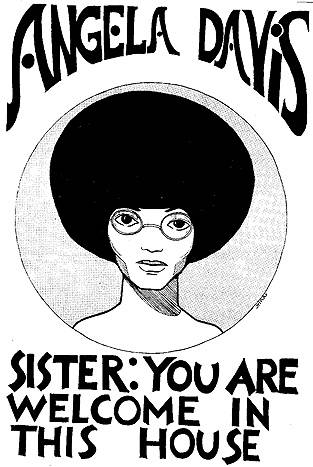Women's Liberation: 1970s, Early Movement: Difference between revisions
m (Protected "Women's Liberation: 1970s, Early Movement" [edit=sysop:move=sysop]) |
m (changed prev document link) |
||
| Line 24: | Line 24: | ||
[[ | [[Good Vibrations: Center of Pleasure Activism |Prev. Document]] [[Mainstream Feminism Responds to 'Sex Positive' |Next Document]] | ||
[[category:Women]] [[category:1960s]] [[category:1970s]] | [[category:Women]] [[category:1960s]] [[category:1970s]] | ||
Latest revision as of 15:34, 18 January 2009
Historical Essay
by Elizabeth Sullivan
Angela Davis support poster, early 1970s.
Fresh from Detroit where she had worked as a health educator, Joani Blank was subletting a friend's apartment for the summer of 1971. She joined the Medical Committee for Human Rights, and at a meeting that summer Maggi Rubenstein leaned over and invited Joani to the next women's liberation consciousness-raising (C-R) group. Joani's invitation was the classical feminist recruitment scene. She went, and continued in C-R groups for several years, as her sexual health and education experience grew.
Later, worker-owners Anne Semans and Cathy Winks, in their book "The Good Vibrations Guide to Sex", would write, "Good Vibrations is part of the grassroots movement of the past decade, in which more and more women have stepped forward to name their own sexual experiences ... We feel that the celebration of female desire is integral to feminism, and that honest communication about sex is a prerequisite to equal rights both in and out of the bedroom." The seeds of this honest communication were nurtured in the consciousness-raising groups of early second wave feminism.
Sex Education
In 1971, Joani Blank had a job at the San Mateo County Health Department doing family planning counseling. Every day she dealt with young women who knew practically nothing about their own sexuality. They were there for birth control or pregnancy counseling, but many had never had an orgasm or taken a look at their own clitorises. The connection between those two facts is more profound than most people are able to admit. At the time, there weren't any perfect resources to point women towards for self-education, few books or pamphlets gave complete information about sex. Almost none communicated a sense of joy or discovery in learning about the topic, or a sense of its importance to a self-realized human life.
Through the early networks springing up among sex education providers in the San Francisco Bay Area, Blank got a job screening candidates for Lonnie Barbach's first pre-orgasmic women's groups. Barbach was training therapists at the University of California, San Francisco to teach her techniques to pre-orgasmic women. Her gradual approach to masturbation was adapted from Joe LoPiccolo's earlier theories, and detailed in her own popular book For Yourself, published in 1975.
Here, Joani met Maggi Rubenstein, a certified nurse who had worked with Joel Fort, and who later went on to co-found San Francisco Sex Information, the Bi Center, and the Institute for the Advanced Study of Human Sexuality. Blank was in Barbach and Rubenstein's first group of volunteers, which also included Carolyn Smith and Toni Ayres (two others who founded the San Francisco Sex Information).
These sex education programs, like many other progressive organizing projects in the Bay Area, were encouraged and funded by the Glide Memorial Church. Glide, a local Methodist church with roots in the civil rights and labor organizing communities, had created a National Sex Forum program, run by Minister Ted McIlvenna, which employed Phyllis Lyon (a prominent leader in San Francisco's feminist and lesbian community). McIlvenna and his friend Dr. Herbert Vandervoot worked together to start the sex counseling program at UCSF.
Their goal was to train medical students to have some comfort with taking care of people's sexual health, so integrally connected to physical health. This small group became known as the "Sex Advisory and Counseling Unit." Here the women's pre-orgasmic group derived a lot more from the model of a Women's Liberation consciousness-raising group than any straight therapy experience. Blank was never formally medically trained, but was gradually becoming a true expert on sexual health and education as she ran workshops, trained students, and started to think through new sex theory.

